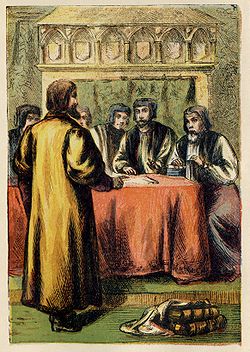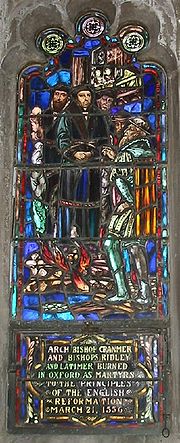
Oxford Martyrs
Encyclopedia
The Oxford Martyrs were tried for heresy
in 1555 and subsequently burnt at the stake in Oxford
, England
, for their religious beliefs and teachings.
The three martyrs were the Anglican bishops Hugh Latimer
, Nicholas Ridley
and Thomas Cranmer
, the Archbishop of Canterbury
.
, the official church of Oxford University on the High Street
. The martyrs were imprisoned at the former Bocardo Prison
near the still extant St Michael at the Northgate
church (at the north gate of the city walls) in Cornmarket Street
. The door of their cell is on display in the tower of the church.
The martyrs were burnt at the stake just outside the city walls to the south, where Broad Street
is now located. Latimer and Ridley were burnt on 16 October 1555. Cranmer was burnt five months later on 21 March 1556.
A small area cobbled with stones forming a cross in the centre of the road outside the front of Balliol College marks the site. The Victorian
spire-like Martyrs' Memorial
, at the south end of St Giles' nearby, commemorates the events. It is claimed that the scorch marks from the flames can still be seen on the doors of Balliol College (now rehung between the Front Quadrangle and Garden Quadrangle).
Three Blind Mice
. It has been speculated that the rhyme refers to Queen Mary I of England blinding and executing the three Oxford Martyrs. However, Ridley, Hugh Latimer
, and Thomas Cranmer were burned, but not blinded.
A possible interpretation of the 'blinding' refer to the fact that Cranmer believed that by recanting his Protestant faith he would save his life. Only when he realised he would be burnt anyway did he recant his earlier recantation and embrace Protestantism again, just before he was excuted. In some ways Mary could have been said to have blindsided Cranmer by leading him to believe he could save himself and executed him anyway and as such 'cut of his tail with a carving knife.'
Heresy
Heresy is a controversial or novel change to a system of beliefs, especially a religion, that conflicts with established dogma. It is distinct from apostasy, which is the formal denunciation of one's religion, principles or cause, and blasphemy, which is irreverence toward religion...
in 1555 and subsequently burnt at the stake in Oxford
Oxford
The city of Oxford is the county town of Oxfordshire, England. The city, made prominent by its medieval university, has a population of just under 165,000, with 153,900 living within the district boundary. It lies about 50 miles north-west of London. The rivers Cherwell and Thames run through...
, England
England
England is a country that is part of the United Kingdom. It shares land borders with Scotland to the north and Wales to the west; the Irish Sea is to the north west, the Celtic Sea to the south west, with the North Sea to the east and the English Channel to the south separating it from continental...
, for their religious beliefs and teachings.
The three martyrs were the Anglican bishops Hugh Latimer
Hugh Latimer
Hugh Latimer was a Fellow of Clare College, Cambridge, Bishop of Worcester before the Reformation, and later Church of England chaplain to King Edward VI. In 1555, under Queen Mary, he was burnt at the stake, becoming one of the three Oxford Martyrs of Anglicanism.-Life:Latimer was born into a...
, Nicholas Ridley
Nicholas Ridley (martyr)
Nicholas Ridley was an English Bishop of London. Ridley was burned at the stake, as one of the Oxford Martyrs, during the Marian Persecutions, for his teachings and his support of Lady Jane Grey...
and Thomas Cranmer
Thomas Cranmer
Thomas Cranmer was a leader of the English Reformation and Archbishop of Canterbury during the reigns of Henry VIII, Edward VI and, for a short time, Mary I. He helped build a favourable case for Henry's divorce from Catherine of Aragon which resulted in the separation of the English Church from...
, the Archbishop of Canterbury
Archbishop of Canterbury
The Archbishop of Canterbury is the senior bishop and principal leader of the Church of England, the symbolic head of the worldwide Anglican Communion, and the diocesan bishop of the Diocese of Canterbury. In his role as head of the Anglican Communion, the archbishop leads the third largest group...
.
History
The three were tried at University Church of St Mary the VirginUniversity Church of St Mary the Virgin
The University Church of St Mary the Virgin is the largest of Oxford's parish churches and the centre from which the University of Oxford grew...
, the official church of Oxford University on the High Street
High Street, Oxford
The High Street in Oxford, England runs between Carfax, generally recognized as the centre of the city, and Magdalen Bridge to the east. Locally the street is often known as The High. It forms a gentle curve and is the subject of many prints, paintings, photographs, etc...
. The martyrs were imprisoned at the former Bocardo Prison
Bocardo Prison
The Bocardo Prison in Oxford, England existed until 1771. Its origins were medieval, and the most celebrated prisoners were the Protestant martyrs Thomas Cranmer, Hugh Latimer and Nicholas Ridley in 1555.-History:...
near the still extant St Michael at the Northgate
St Michael at the Northgate
St Michael at the North Gate is a church in Cornmarket Street, at the junction with Ship Street, in central Oxford, England. The church is so-called because this is the location of the original north gate of Oxford when it was surrounded by a city wall....
church (at the north gate of the city walls) in Cornmarket Street
Cornmarket Street
Cornmarket Street is a major shopping street and pedestrian precinct in Oxford, England that runs north-south between Carfax Tower and Magdalen Street.Retailers in Cornmarket include:* Austin Reed...
. The door of their cell is on display in the tower of the church.
The martyrs were burnt at the stake just outside the city walls to the south, where Broad Street
Broad Street, Oxford
Broad Street is a wide street in central Oxford, England, located just north of the old city wall.The street is known for its bookshops, including the original Blackwell's bookshop at number 50, located here due to the University...
is now located. Latimer and Ridley were burnt on 16 October 1555. Cranmer was burnt five months later on 21 March 1556.
A small area cobbled with stones forming a cross in the centre of the road outside the front of Balliol College marks the site. The Victorian
Victorian architecture
The term Victorian architecture refers collectively to several architectural styles employed predominantly during the middle and late 19th century. The period that it indicates may slightly overlap the actual reign, 20 June 1837 – 22 January 1901, of Queen Victoria. This represents the British and...
spire-like Martyrs' Memorial
Martyrs' Memorial
The Martyrs' Memorial is a stone monument positioned at the intersection of St Giles', Magdalen Street and Beaumont Street in Oxford, England just outside Balliol College...
, at the south end of St Giles' nearby, commemorates the events. It is claimed that the scorch marks from the flames can still be seen on the doors of Balliol College (now rehung between the Front Quadrangle and Garden Quadrangle).
Legacy
There has been an attempt to connect the Oxford Martyrs with the nursery rhymeNursery rhyme
The term nursery rhyme is used for "traditional" poems for young children in Britain and many other countries, but usage only dates from the 19th century and in North America the older ‘Mother Goose Rhymes’ is still often used.-Lullabies:...
Three Blind Mice
Three Blind Mice
Three Blind Mice is an English nursery rhyme and musical round. It has a Roud Folk Song Index number of 3753.-Lyrics:The modern words are:-Variations and uses:Amateur music composer Thomas Oliphant noted in 1843 that:...
. It has been speculated that the rhyme refers to Queen Mary I of England blinding and executing the three Oxford Martyrs. However, Ridley, Hugh Latimer
Hugh Latimer
Hugh Latimer was a Fellow of Clare College, Cambridge, Bishop of Worcester before the Reformation, and later Church of England chaplain to King Edward VI. In 1555, under Queen Mary, he was burnt at the stake, becoming one of the three Oxford Martyrs of Anglicanism.-Life:Latimer was born into a...
, and Thomas Cranmer were burned, but not blinded.
A possible interpretation of the 'blinding' refer to the fact that Cranmer believed that by recanting his Protestant faith he would save his life. Only when he realised he would be burnt anyway did he recant his earlier recantation and embrace Protestantism again, just before he was excuted. In some ways Mary could have been said to have blindsided Cranmer by leading him to believe he could save himself and executed him anyway and as such 'cut of his tail with a carving knife.'
Gallery
 |
  |
See also
- Christian martyrsChristian martyrsA Christian martyr is one who is killed for following Christianity, through stoning, crucifixion, burning at the stake or other forms of torture and capital punishment. The word "martyr" comes from the Greek word μάρτυς, mártys, which means "witness."...
- Religion in the United KingdomReligion in the United KingdomReligion in the United Kingdom and the states that pre-dated the UK, was dominated by forms of Christianity for over 1,400 years. Although a majority of citizens still identify with Christianity in many surveys, regular church attendance has fallen dramatically since the middle of the 20th century,...
- James BrooksJames Brooks (Bishop)James Brooks D.D. was an English Catholic bishop.Born in May 1512, in Hampshire, southern England, he became a Fellow of Corpus Christi College, Oxford in 1532, took the B.A. that same year and in 1546 the D.D. He was Master of Balliol College, Oxford in the years 1547–1555...
, one of the papal sub-delegates in the Royal CommissionRoyal CommissionIn Commonwealth realms and other monarchies a Royal Commission is a major ad-hoc formal public inquiry into a defined issue. They have been held in various countries such as the United Kingdom, Australia, Canada, New Zealand, and Saudi Arabia...
for the trial

